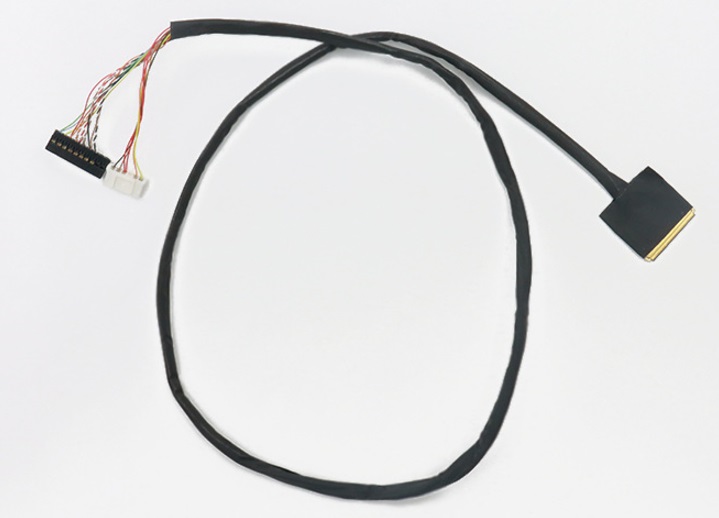What is the reason about Robot screen cannot be displayed-is the EDP cable ?

Detailed Explanation of Screen Display Failure Caused by Poor EDP Cable Connection
EDP (Embedded DisplayPort) cables, as high-speed, high-bandwidth digital display interface cables, are widely used in various electronic devices, especially in industrial all-in-one machines, high-end displays, and embedded systems. However, poor EDP cable connection is a common issue that can lead to the screen failing to display properly, causing inconvenience to users. This article provides a detailed explanation covering the basics of EDP cables, reasons for poor connections, fault phenomena, diagnostic methods, and solutions.
I. Introduction to
EDP Cables
EDP cables are display interface cables specifically designed for embedded systems. Compared to traditional interfaces such as VGA and DVI, EDP cables offer higher bandwidth and lower power consumption, supporting higher resolutions and refresh rates. They are typically used to connect the motherboard to the screen, responsible for transmitting image and control signals. EDP cables contain multiple differential signal lines for high-speed data transmission, along with an auxiliary channel (AUX CH) for control signals and configuration information.
II. Reasons for Poor EDP Cable Connection
Poor EDP cable connection can be caused by various factors, mainly including the following:
1. Physical Damage: EDP cables may suffer external impacts or excessive bending during transportation, installation, or use, leading to physical damage such as breaks, cracks, or bent pins.
2. Poor Contact: The connecting sockets or plugs of EDP cables may have poor contact due to design defects, manufacturing flaws, or long-term use. Additionally, dust, oxides, or corrosion between the plug and socket can also cause poor contact.
3. Incorrect Connection Method: If the plug and socket are not properly aligned or not fully inserted during the connection of the EDP cable, it may also result in poor connection.
4. Cable Aging: Prolonged use and frequent folding can lead to aging of the EDP cable, and the internal metal conductors may break or have poor contact.
III. Fault Phenomena
When there is a poor EDP cable connection, the screen may exhibit the following fault phenomena:
1. No Display on Screen: This is the most common fault phenomenon, where the screen is completely black without any display.
2. Abnormal Display: In some cases, poor EDP cable connection may cause abnormal screen display, such as image flickering, color distortion, or image deformation.
3. Signal Loss: During the connection process, if the EDP cable has a poor connection, it may lead to signal loss, with the screen displaying prompts like "no signal" or "no input".
IV. Diagnostic Methods
To accurately diagnose the issue of poor EDP cable connection, the following steps can be taken:
1. Visual Inspection: First, inspect the appearance of the EDP cable for any obvious damage, breaks, or bent pins.
2. Connection Check: Check if the plug and socket of the EDP cable are securely connected and if there is any looseness or poor contact. Try reconnecting the plug to see if the issue can be resolved.
3. Signal Testing: Use tools such as signal generators or oscilloscopes to test the signal transmission of the EDP cable and see if it can normally transmit image and control signals.
4. Replacement Test: If it is suspected that the EDP cable itself has an issue, try replacing it with a new one to see if the problem can be resolved.
V. Solutions
To address the issue of the screen failing to display due to poor EDP cable connection, the following solutions can be adopted:
1. Reconnect the Cable: If the poor EDP cable connection is caused by looseness or poor contact between the plug and socket, try reconnecting the cable to ensure a secure connection.
2. Clean the Interface: If dust, oxides, or corrosion between the plug and socket cause poor contact, use a professional electronic cleaning spray or pure alcohol to gently wipe the interface and remove dust or oxides. However, avoid using overly wet cleaning products to prevent damage to the interface.
3. Replace the EDP Cable: If the EDP cable itself has physical damage or aging issues, replace it with a new one. When choosing a new cable, select a reliable and standard-compliant EDP cable.
4. Check the Motherboard and Screen Interface: If the issue persists after replacing the EDP cable, there may be an issue with the motherboard or screen interface. In this case, check the interfaces for any damage or deformation and repair or replace them if necessary.
VI. Preventive Measures
To prevent the issue of the
screen failing to display due to poor EDP cable connection, the following preventive measures can be taken:
1. Proper Connection: When connecting the EDP cable, ensure that the plug and socket are properly aligned and fully inserted to avoid looseness or poor contact.
2. Avoid Physical Damage: During use and transportation, avoid causing physical damage to the EDP cable, such as excessive bending, pulling, or impact.
3. Regular Inspection: Regularly inspect and maintain the EDP cable to promptly identify and address any issues.
4. Choose Reliable Cables: When purchasing EDP cables, choose reliable and standard-compliant ones to avoid issues caused by inferior cables.
In summary, poor EDP cable connection is a common issue that can lead to the screen failing to display properly. By using correct diagnostic methods and solutions, we can quickly identify the problem and take effective measures to fix it. Additionally, by strengthening preventive measures, we can reduce the risk of poor EDP cable connection and improve the stability and reliability of the equipment.
